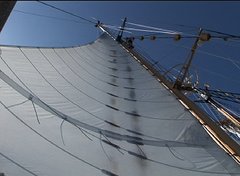
Students furling a small sail aboard the Seamans.
The RCS is in the South Pacific Gyre where we can report very warm waters, oliogtrophic seas and fair breezes, minor squalls and occasionally no wind at all! We're heading toward the Marquesas and Science is in full swing. We daily are collecting CTD casts with Niskin water bottles that are collecting samples for nutrients, chlorophyll and carbon. Nets are going in daily at noon and midnight aswe target the biodiversity of the epipelagic to the mesopelagic. Diverse creatures from pteropods to porpita greet us daily.
We're heading toward Nuka Hiva and the next 3 days will be filled with stations for the Island Mass project that Ethan and Eugene are heading up. In the midst of this oligotrophic, low-productivity sea they hope to identify how and why regions of high productivity occur in association with the Islands. Satellite imagery provided by Dave Foley of NOAA has guided our approach and late tonight we start a series of 5-6 stations to see what exactly occurs in the water column around this area. Fishing has picked up, with animals as diverse as tunas, wahoo and spearfish attacking some of the baits we're towing for sampling the epipelagic.
Spirits are high among our students, and all is well aboard the RCS as we are getting into the rhythm of beingat sea.
Dr. Barbara Block


1 comment:
Would also love to know what the skies are like at night. I hope someone on board has a good telescope with stabilization features. :-)
Post a Comment